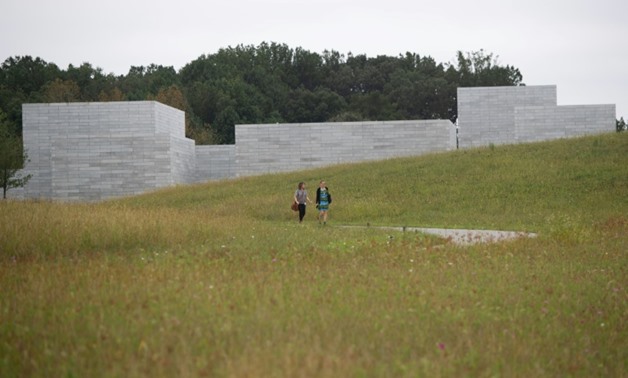
Glenstone's Pavilions complex adds 204,000 square feet (19,000 square meters) of gallery space to the private museum, now one of the world's largest.
It may be the greatest art collection you've never heard of -- until now.
With a sprawling gallery space opening Thursday in a prosperous exurb of Washington, Glenstone has become one of the world's biggest private art museums.
At a time when museums are courting Instagram-hungry crowds and visitors have to elbow each other to catch a glimpse, Glenstone has carefully choreographed a journey in the opposite direction as part of its $200 million expansion.
Birdsong and crickets provide the soothing cadence to the 10-minute walk from the parking lot to the new building, along a gravel path carved into rolling hills dotted with wildflowers, sycamore and oak trees.
"Split Rocker," a giant flower-covered sculpture by the equally polarizing and famous Jeff Koons is perched atop a hill gazing toward the 204,000-square-foot (19,000-square-meter) Pavilions complex.
A water court of aquatic plants ringed by walls of glass provides the beating heart of the Thomas Phifer-designed building, flooded with natural light and shaped with individually poured blocks of gray concrete.
The Pavilions' 11 interconnected structures are embedded into the 230 acres (93 hectares) of this former foxhunting estate.
"It's all very carefully calibrated to allow for that prolonged experience," said director Emily Rales, 42, who co-founded Glenstone with her husband Mitchell, a 62-year-old billionaire industrialist.
In an interview, she spoke of their "personal quest to find those quiet moments where you can really sit with a work of art and not feel rushed or pressured to move on."
The setting provides an experience that changes with the seasons and from dawn to dusk in what remains the Raleses' (tax-exempt) backyard.
Glenstone's collection of post-World War II art is considered to be one of the best, including works by Louise Bourgeois, Roni Horn and Richard Serra, who has two torqued steel sculptures on the grounds.
In a radical departure from most other museums, the walls are barren of explanatory texts and some rooms have just a single work of art.
Gray-uniformed guides, many of them in a young professionals training program, politely engage visitors in discussions about what lies before their eyes.
- 'Here for you' -
Brice Marden's majestic "Moss Sutra with the Seasons" (2010-2015) -- his only commissioned work -- stands alone in a space designed in collaboration with the artist.
Lit through clerestory windows, the painting features four monochrome panels inspired by seasonal colors, while a larger one in the center reveals mossy green calligraphic squiggles typical of Marden's later years.
A square, skylit room presents On Kawara's "Moon Landing," three large-scale black canvases each indicating in white script a key date during the July 1969 Apollo 11 lunar landing mission.
"We have made this commitment to artists by saying, look, we know that what you're asking is tremendous and it's difficult to do, but we're here for you and we will do whatever we can to realize that vision for you," explained Emily Rales, who studied art history at prestigious Wellesley College before directing New York's Gladstone Gallery.
"That is very valuable for an artist working today."
There were 70 meetings with Robert Gober and his studio about his 1992 "Untitled" installation of large sinks with open taps set against a woodlands wallpaper with barred windows. Newspapers are strewn about the floor.
- 'Champion of the underdog' -
On the tombstone of Mitchell Rales' father, a man who rose from a hardscrabble childhood in an orphanage to become a successful businessman, reads the inscription "Champion of the Underdog."
Glenstone espouses that same motto by presenting works the Raleses dub as "challenging."
The building's largest room takes visitors on a trip through art history from 1943 to 1989 with 65 works by 52 artists.
Pulled from Glenstone's holdings of some 1,300 pieces, they feature many women artists as well as less familiar works.
There's Abstract Expressionism and Japan's Gutai, Brazil's Neo-Concrete, Arte Povera, Minimalism and post-Minimalism. Works by Lygia Clark and Akira Kanayama can be seen near household names like Jackson Pollock and Mark Rothko.
In a separate gallery, visitors can take in a framed view of a hillside while sitting on a softly curved maple bench inviting quiet contemplation at nature's altar.
Glenstone has been open since 2006, but only received 10,000 visitors in its first seven years using a much smaller space designed by architect Charles Gwathmey.
It can now accommodate up to 100,000 people a year, though it is initially limiting visits to 400 per day four days a week, with free online reservations required.


Comments
Leave a Comment